Management of Buyer-Supplier Power in the Procurement Process
VerifiedAdded on 2023/01/19
|13
|3900
|51
Report
AI Summary
This report delves into the intricacies of buyer-supplier power within the context of supply chain management, emphasizing its impact on the procurement process. It explores how managers can effectively incorporate the concept of buyer-supplier power to mitigate potential risks and optimize outcomes. The report highlights the importance of needs assessment, considering both organizational and customer needs, to align procurement decisions with strategic goals. It examines how understanding buyer and supplier needs can reduce their power, fostering a more balanced relationship. The report discusses the significance of sourcing strategies in managing buyer-supplier dynamics, emphasizing the need to consider quality, shelf life, price, and cultural factors. Furthermore, it provides insights into how managers can navigate the complexities of buyer-supplier relationships to ensure efficient and effective procurement processes. By addressing supplier needs such as consistency, acknowledgment, and fair pricing, the report suggests strategies to reduce supplier power and ensure a stable supply chain. The report concludes by emphasizing the importance of proactive management to maintain a competitive edge and achieve organizational objectives.

SUPPLY CHAIN 1
SUPPLY CHAIN
Student’s Name
Professor’s Name
Institution
Course
Date
SUPPLY CHAIN
Student’s Name
Professor’s Name
Institution
Course
Date
Paraphrase This Document
Need a fresh take? Get an instant paraphrase of this document with our AI Paraphraser
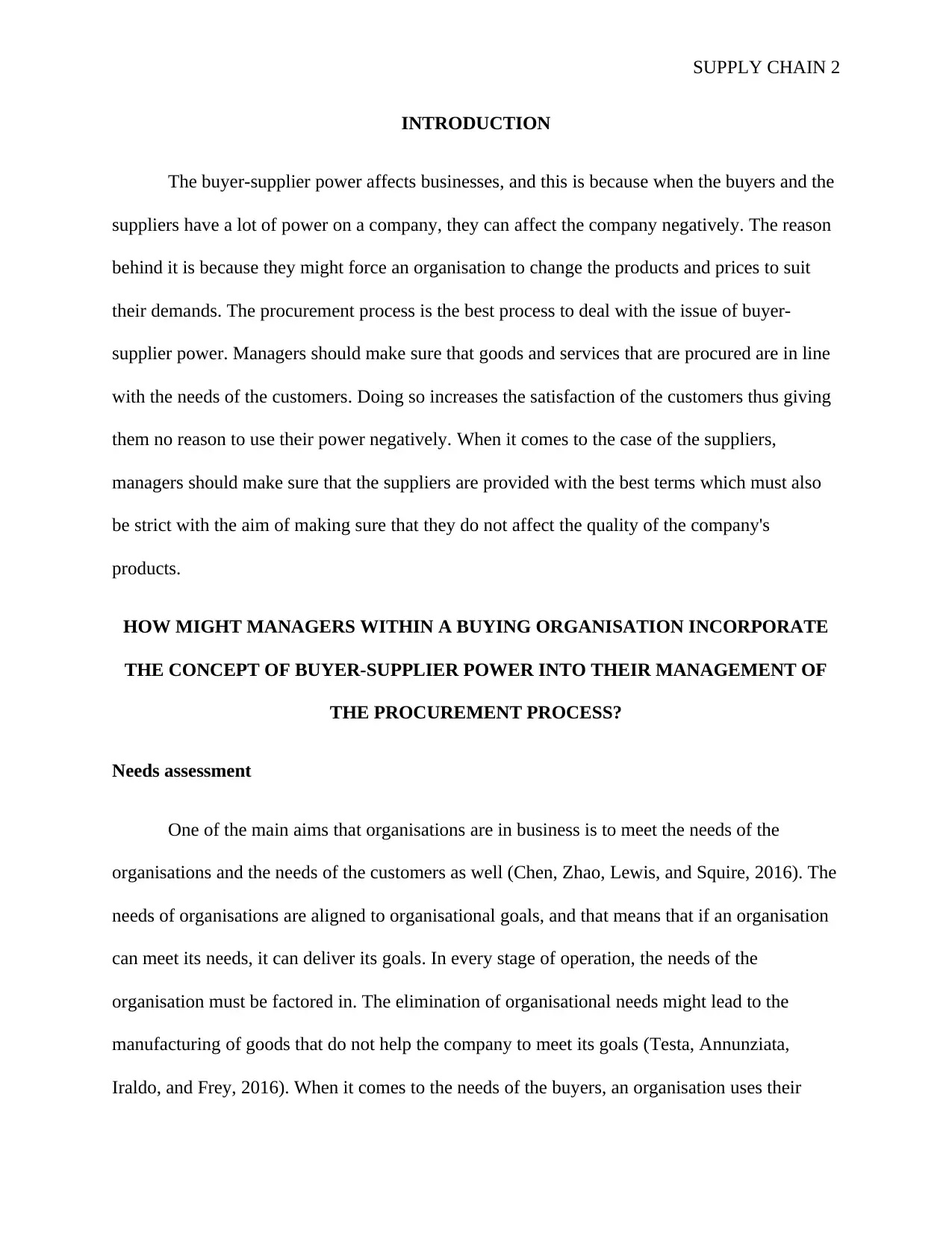
SUPPLY CHAIN 2
INTRODUCTION
The buyer-supplier power affects businesses, and this is because when the buyers and the
suppliers have a lot of power on a company, they can affect the company negatively. The reason
behind it is because they might force an organisation to change the products and prices to suit
their demands. The procurement process is the best process to deal with the issue of buyer-
supplier power. Managers should make sure that goods and services that are procured are in line
with the needs of the customers. Doing so increases the satisfaction of the customers thus giving
them no reason to use their power negatively. When it comes to the case of the suppliers,
managers should make sure that the suppliers are provided with the best terms which must also
be strict with the aim of making sure that they do not affect the quality of the company's
products.
HOW MIGHT MANAGERS WITHIN A BUYING ORGANISATION INCORPORATE
THE CONCEPT OF BUYER-SUPPLIER POWER INTO THEIR MANAGEMENT OF
THE PROCUREMENT PROCESS?
Needs assessment
One of the main aims that organisations are in business is to meet the needs of the
organisations and the needs of the customers as well (Chen, Zhao, Lewis, and Squire, 2016). The
needs of organisations are aligned to organisational goals, and that means that if an organisation
can meet its needs, it can deliver its goals. In every stage of operation, the needs of the
organisation must be factored in. The elimination of organisational needs might lead to the
manufacturing of goods that do not help the company to meet its goals (Testa, Annunziata,
Iraldo, and Frey, 2016). When it comes to the needs of the buyers, an organisation uses their
INTRODUCTION
The buyer-supplier power affects businesses, and this is because when the buyers and the
suppliers have a lot of power on a company, they can affect the company negatively. The reason
behind it is because they might force an organisation to change the products and prices to suit
their demands. The procurement process is the best process to deal with the issue of buyer-
supplier power. Managers should make sure that goods and services that are procured are in line
with the needs of the customers. Doing so increases the satisfaction of the customers thus giving
them no reason to use their power negatively. When it comes to the case of the suppliers,
managers should make sure that the suppliers are provided with the best terms which must also
be strict with the aim of making sure that they do not affect the quality of the company's
products.
HOW MIGHT MANAGERS WITHIN A BUYING ORGANISATION INCORPORATE
THE CONCEPT OF BUYER-SUPPLIER POWER INTO THEIR MANAGEMENT OF
THE PROCUREMENT PROCESS?
Needs assessment
One of the main aims that organisations are in business is to meet the needs of the
organisations and the needs of the customers as well (Chen, Zhao, Lewis, and Squire, 2016). The
needs of organisations are aligned to organisational goals, and that means that if an organisation
can meet its needs, it can deliver its goals. In every stage of operation, the needs of the
organisation must be factored in. The elimination of organisational needs might lead to the
manufacturing of goods that do not help the company to meet its goals (Testa, Annunziata,
Iraldo, and Frey, 2016). When it comes to the needs of the buyers, an organisation uses their
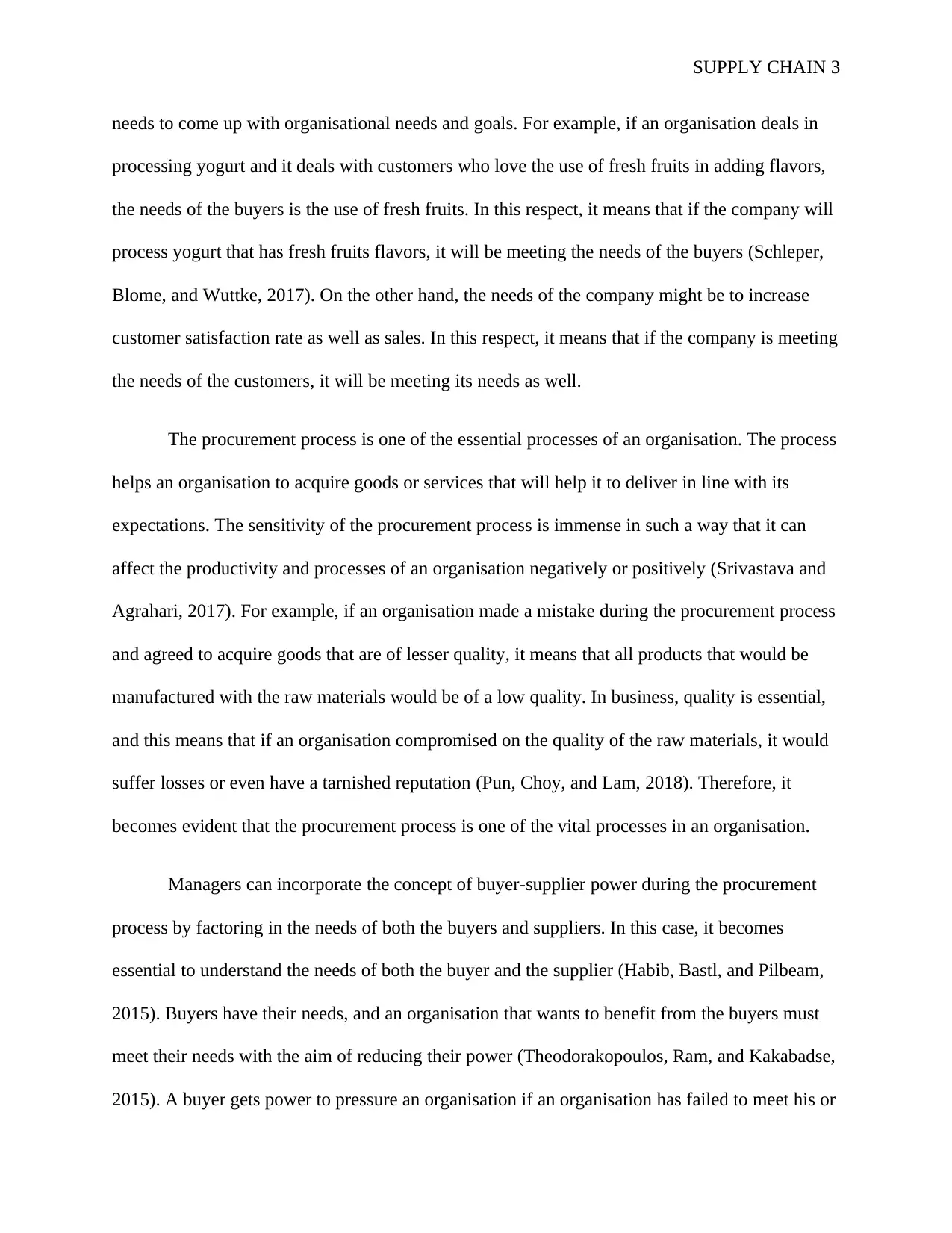
SUPPLY CHAIN 3
needs to come up with organisational needs and goals. For example, if an organisation deals in
processing yogurt and it deals with customers who love the use of fresh fruits in adding flavors,
the needs of the buyers is the use of fresh fruits. In this respect, it means that if the company will
process yogurt that has fresh fruits flavors, it will be meeting the needs of the buyers (Schleper,
Blome, and Wuttke, 2017). On the other hand, the needs of the company might be to increase
customer satisfaction rate as well as sales. In this respect, it means that if the company is meeting
the needs of the customers, it will be meeting its needs as well.
The procurement process is one of the essential processes of an organisation. The process
helps an organisation to acquire goods or services that will help it to deliver in line with its
expectations. The sensitivity of the procurement process is immense in such a way that it can
affect the productivity and processes of an organisation negatively or positively (Srivastava and
Agrahari, 2017). For example, if an organisation made a mistake during the procurement process
and agreed to acquire goods that are of lesser quality, it means that all products that would be
manufactured with the raw materials would be of a low quality. In business, quality is essential,
and this means that if an organisation compromised on the quality of the raw materials, it would
suffer losses or even have a tarnished reputation (Pun, Choy, and Lam, 2018). Therefore, it
becomes evident that the procurement process is one of the vital processes in an organisation.
Managers can incorporate the concept of buyer-supplier power during the procurement
process by factoring in the needs of both the buyers and suppliers. In this case, it becomes
essential to understand the needs of both the buyer and the supplier (Habib, Bastl, and Pilbeam,
2015). Buyers have their needs, and an organisation that wants to benefit from the buyers must
meet their needs with the aim of reducing their power (Theodorakopoulos, Ram, and Kakabadse,
2015). A buyer gets power to pressure an organisation if an organisation has failed to meet his or
needs to come up with organisational needs and goals. For example, if an organisation deals in
processing yogurt and it deals with customers who love the use of fresh fruits in adding flavors,
the needs of the buyers is the use of fresh fruits. In this respect, it means that if the company will
process yogurt that has fresh fruits flavors, it will be meeting the needs of the buyers (Schleper,
Blome, and Wuttke, 2017). On the other hand, the needs of the company might be to increase
customer satisfaction rate as well as sales. In this respect, it means that if the company is meeting
the needs of the customers, it will be meeting its needs as well.
The procurement process is one of the essential processes of an organisation. The process
helps an organisation to acquire goods or services that will help it to deliver in line with its
expectations. The sensitivity of the procurement process is immense in such a way that it can
affect the productivity and processes of an organisation negatively or positively (Srivastava and
Agrahari, 2017). For example, if an organisation made a mistake during the procurement process
and agreed to acquire goods that are of lesser quality, it means that all products that would be
manufactured with the raw materials would be of a low quality. In business, quality is essential,
and this means that if an organisation compromised on the quality of the raw materials, it would
suffer losses or even have a tarnished reputation (Pun, Choy, and Lam, 2018). Therefore, it
becomes evident that the procurement process is one of the vital processes in an organisation.
Managers can incorporate the concept of buyer-supplier power during the procurement
process by factoring in the needs of both the buyers and suppliers. In this case, it becomes
essential to understand the needs of both the buyer and the supplier (Habib, Bastl, and Pilbeam,
2015). Buyers have their needs, and an organisation that wants to benefit from the buyers must
meet their needs with the aim of reducing their power (Theodorakopoulos, Ram, and Kakabadse,
2015). A buyer gets power to pressure an organisation if an organisation has failed to meet his or
⊘ This is a preview!⊘
Do you want full access?
Subscribe today to unlock all pages.

Trusted by 1+ million students worldwide
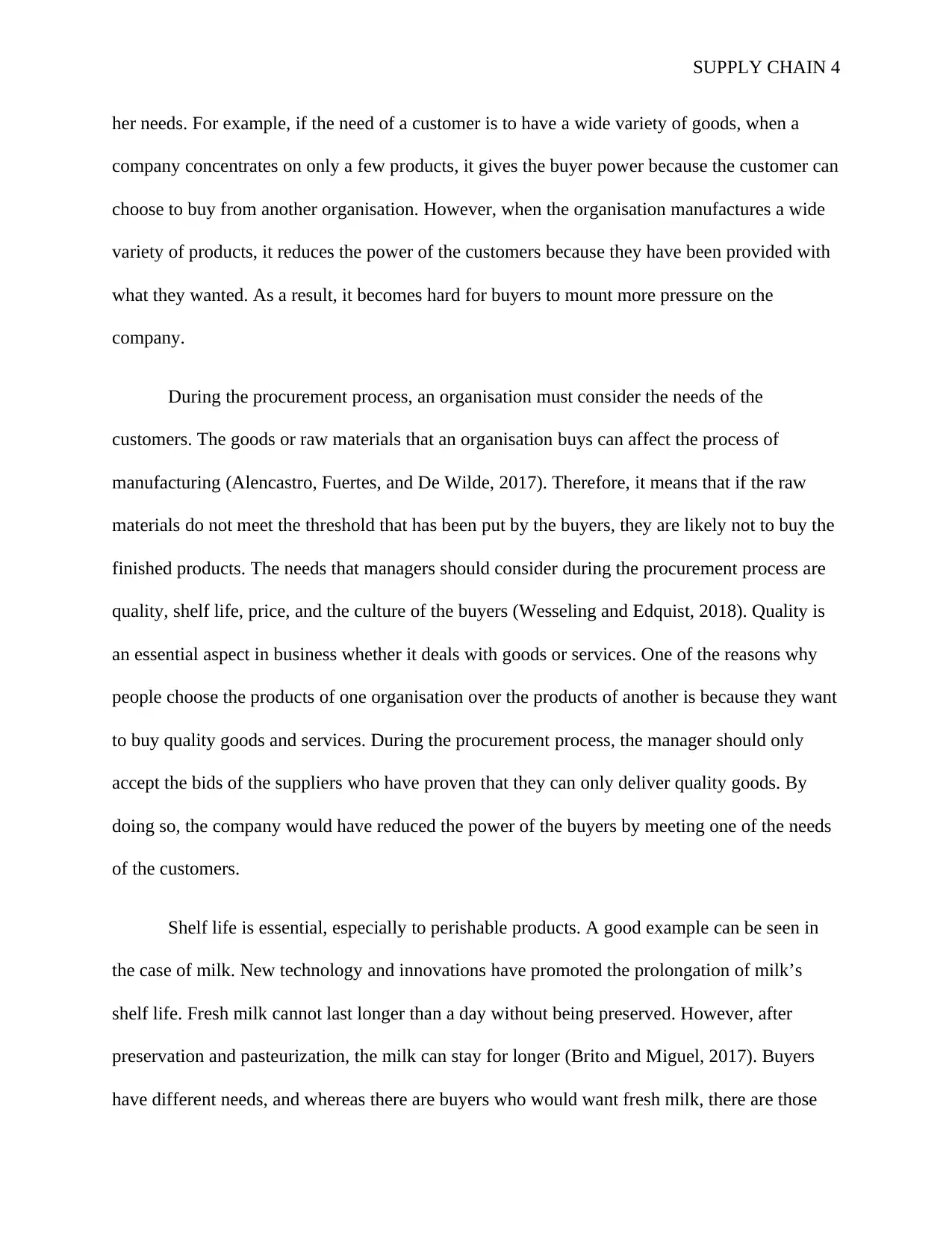
SUPPLY CHAIN 4
her needs. For example, if the need of a customer is to have a wide variety of goods, when a
company concentrates on only a few products, it gives the buyer power because the customer can
choose to buy from another organisation. However, when the organisation manufactures a wide
variety of products, it reduces the power of the customers because they have been provided with
what they wanted. As a result, it becomes hard for buyers to mount more pressure on the
company.
During the procurement process, an organisation must consider the needs of the
customers. The goods or raw materials that an organisation buys can affect the process of
manufacturing (Alencastro, Fuertes, and De Wilde, 2017). Therefore, it means that if the raw
materials do not meet the threshold that has been put by the buyers, they are likely not to buy the
finished products. The needs that managers should consider during the procurement process are
quality, shelf life, price, and the culture of the buyers (Wesseling and Edquist, 2018). Quality is
an essential aspect in business whether it deals with goods or services. One of the reasons why
people choose the products of one organisation over the products of another is because they want
to buy quality goods and services. During the procurement process, the manager should only
accept the bids of the suppliers who have proven that they can only deliver quality goods. By
doing so, the company would have reduced the power of the buyers by meeting one of the needs
of the customers.
Shelf life is essential, especially to perishable products. A good example can be seen in
the case of milk. New technology and innovations have promoted the prolongation of milk’s
shelf life. Fresh milk cannot last longer than a day without being preserved. However, after
preservation and pasteurization, the milk can stay for longer (Brito and Miguel, 2017). Buyers
have different needs, and whereas there are buyers who would want fresh milk, there are those
her needs. For example, if the need of a customer is to have a wide variety of goods, when a
company concentrates on only a few products, it gives the buyer power because the customer can
choose to buy from another organisation. However, when the organisation manufactures a wide
variety of products, it reduces the power of the customers because they have been provided with
what they wanted. As a result, it becomes hard for buyers to mount more pressure on the
company.
During the procurement process, an organisation must consider the needs of the
customers. The goods or raw materials that an organisation buys can affect the process of
manufacturing (Alencastro, Fuertes, and De Wilde, 2017). Therefore, it means that if the raw
materials do not meet the threshold that has been put by the buyers, they are likely not to buy the
finished products. The needs that managers should consider during the procurement process are
quality, shelf life, price, and the culture of the buyers (Wesseling and Edquist, 2018). Quality is
an essential aspect in business whether it deals with goods or services. One of the reasons why
people choose the products of one organisation over the products of another is because they want
to buy quality goods and services. During the procurement process, the manager should only
accept the bids of the suppliers who have proven that they can only deliver quality goods. By
doing so, the company would have reduced the power of the buyers by meeting one of the needs
of the customers.
Shelf life is essential, especially to perishable products. A good example can be seen in
the case of milk. New technology and innovations have promoted the prolongation of milk’s
shelf life. Fresh milk cannot last longer than a day without being preserved. However, after
preservation and pasteurization, the milk can stay for longer (Brito and Miguel, 2017). Buyers
have different needs, and whereas there are buyers who would want fresh milk, there are those
Paraphrase This Document
Need a fresh take? Get an instant paraphrase of this document with our AI Paraphraser
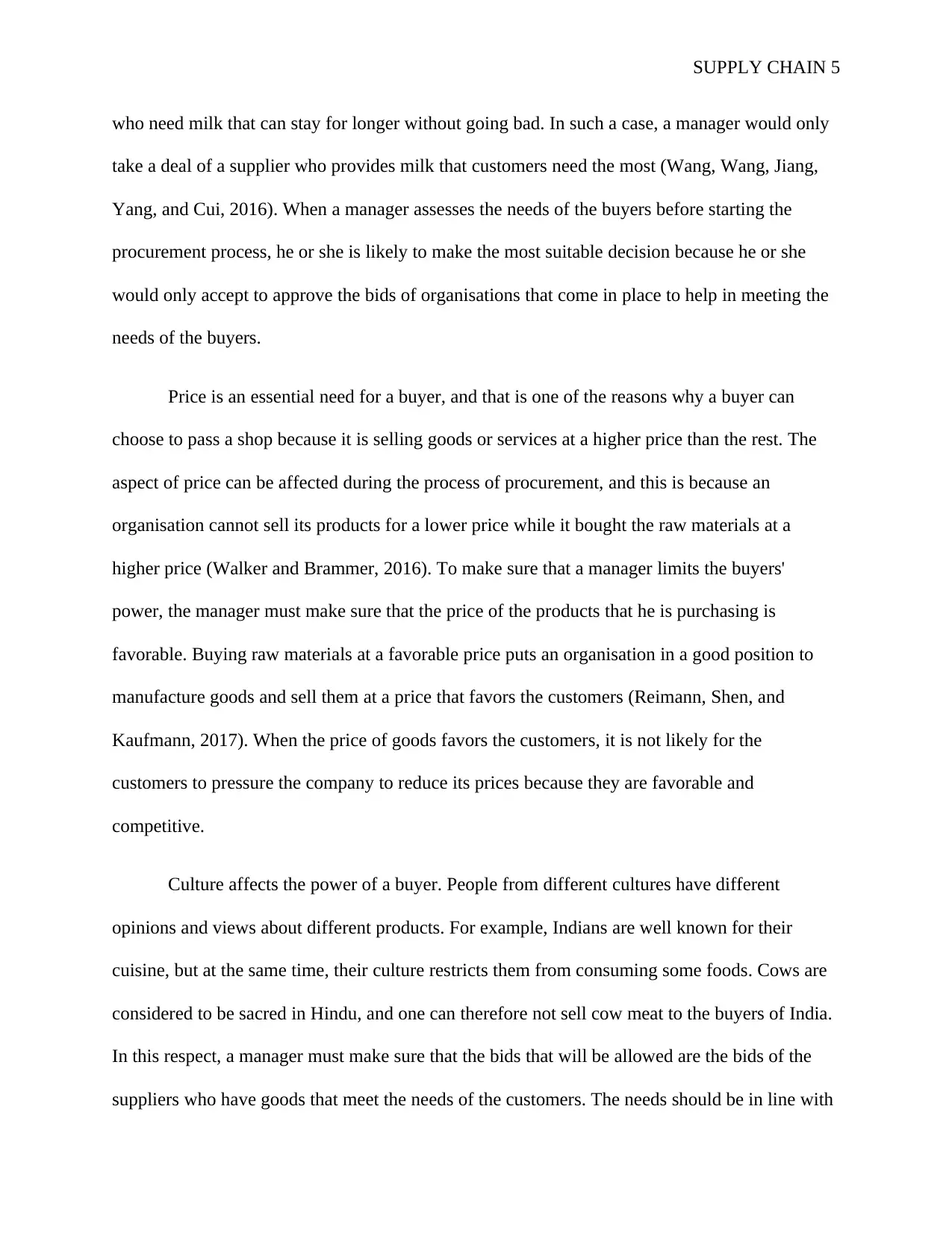
SUPPLY CHAIN 5
who need milk that can stay for longer without going bad. In such a case, a manager would only
take a deal of a supplier who provides milk that customers need the most (Wang, Wang, Jiang,
Yang, and Cui, 2016). When a manager assesses the needs of the buyers before starting the
procurement process, he or she is likely to make the most suitable decision because he or she
would only accept to approve the bids of organisations that come in place to help in meeting the
needs of the buyers.
Price is an essential need for a buyer, and that is one of the reasons why a buyer can
choose to pass a shop because it is selling goods or services at a higher price than the rest. The
aspect of price can be affected during the process of procurement, and this is because an
organisation cannot sell its products for a lower price while it bought the raw materials at a
higher price (Walker and Brammer, 2016). To make sure that a manager limits the buyers'
power, the manager must make sure that the price of the products that he is purchasing is
favorable. Buying raw materials at a favorable price puts an organisation in a good position to
manufacture goods and sell them at a price that favors the customers (Reimann, Shen, and
Kaufmann, 2017). When the price of goods favors the customers, it is not likely for the
customers to pressure the company to reduce its prices because they are favorable and
competitive.
Culture affects the power of a buyer. People from different cultures have different
opinions and views about different products. For example, Indians are well known for their
cuisine, but at the same time, their culture restricts them from consuming some foods. Cows are
considered to be sacred in Hindu, and one can therefore not sell cow meat to the buyers of India.
In this respect, a manager must make sure that the bids that will be allowed are the bids of the
suppliers who have goods that meet the needs of the customers. The needs should be in line with
who need milk that can stay for longer without going bad. In such a case, a manager would only
take a deal of a supplier who provides milk that customers need the most (Wang, Wang, Jiang,
Yang, and Cui, 2016). When a manager assesses the needs of the buyers before starting the
procurement process, he or she is likely to make the most suitable decision because he or she
would only accept to approve the bids of organisations that come in place to help in meeting the
needs of the buyers.
Price is an essential need for a buyer, and that is one of the reasons why a buyer can
choose to pass a shop because it is selling goods or services at a higher price than the rest. The
aspect of price can be affected during the process of procurement, and this is because an
organisation cannot sell its products for a lower price while it bought the raw materials at a
higher price (Walker and Brammer, 2016). To make sure that a manager limits the buyers'
power, the manager must make sure that the price of the products that he is purchasing is
favorable. Buying raw materials at a favorable price puts an organisation in a good position to
manufacture goods and sell them at a price that favors the customers (Reimann, Shen, and
Kaufmann, 2017). When the price of goods favors the customers, it is not likely for the
customers to pressure the company to reduce its prices because they are favorable and
competitive.
Culture affects the power of a buyer. People from different cultures have different
opinions and views about different products. For example, Indians are well known for their
cuisine, but at the same time, their culture restricts them from consuming some foods. Cows are
considered to be sacred in Hindu, and one can therefore not sell cow meat to the buyers of India.
In this respect, a manager must make sure that the bids that will be allowed are the bids of the
suppliers who have goods that meet the needs of the customers. The needs should be in line with
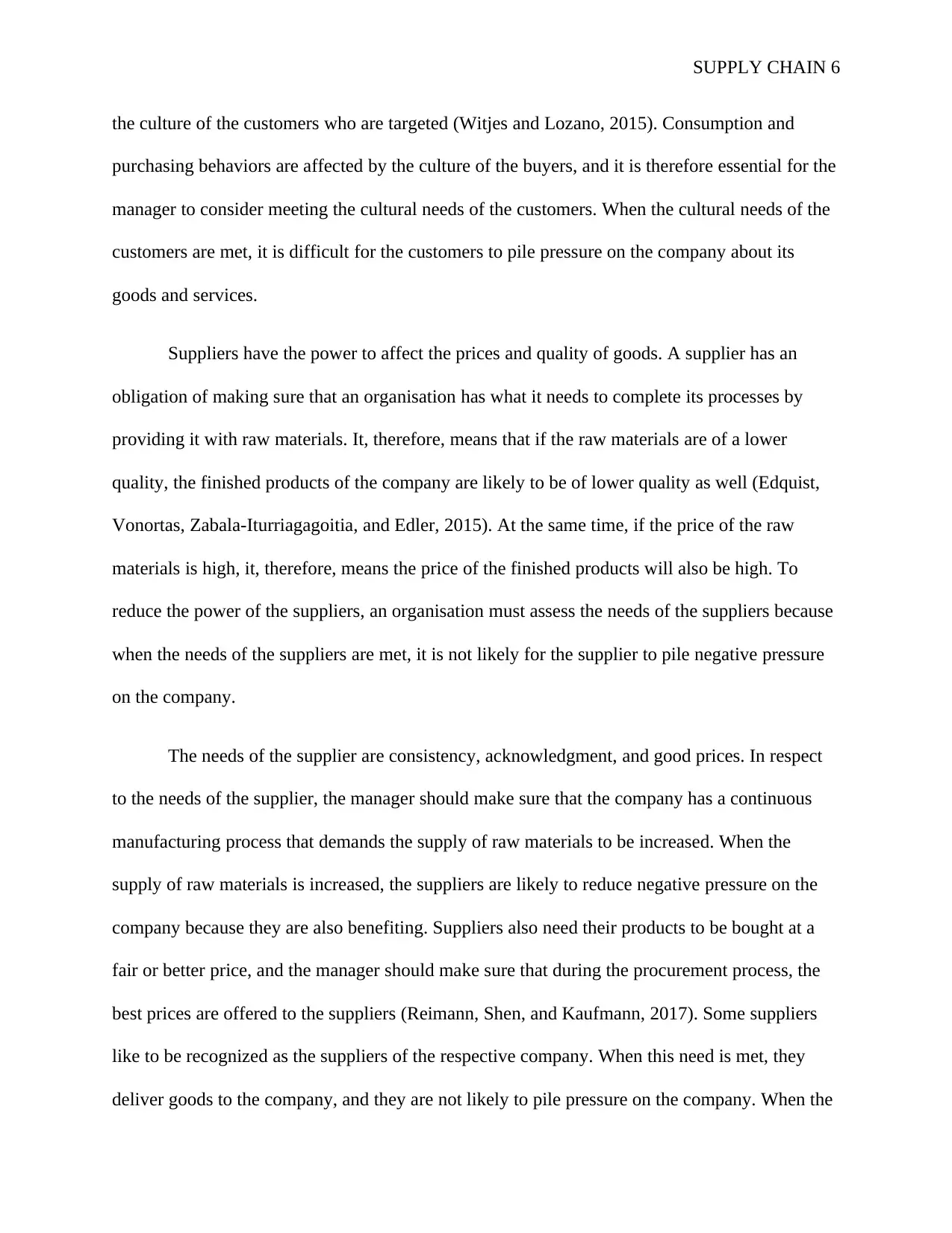
SUPPLY CHAIN 6
the culture of the customers who are targeted (Witjes and Lozano, 2015). Consumption and
purchasing behaviors are affected by the culture of the buyers, and it is therefore essential for the
manager to consider meeting the cultural needs of the customers. When the cultural needs of the
customers are met, it is difficult for the customers to pile pressure on the company about its
goods and services.
Suppliers have the power to affect the prices and quality of goods. A supplier has an
obligation of making sure that an organisation has what it needs to complete its processes by
providing it with raw materials. It, therefore, means that if the raw materials are of a lower
quality, the finished products of the company are likely to be of lower quality as well (Edquist,
Vonortas, Zabala-Iturriagagoitia, and Edler, 2015). At the same time, if the price of the raw
materials is high, it, therefore, means the price of the finished products will also be high. To
reduce the power of the suppliers, an organisation must assess the needs of the suppliers because
when the needs of the suppliers are met, it is not likely for the supplier to pile negative pressure
on the company.
The needs of the supplier are consistency, acknowledgment, and good prices. In respect
to the needs of the supplier, the manager should make sure that the company has a continuous
manufacturing process that demands the supply of raw materials to be increased. When the
supply of raw materials is increased, the suppliers are likely to reduce negative pressure on the
company because they are also benefiting. Suppliers also need their products to be bought at a
fair or better price, and the manager should make sure that during the procurement process, the
best prices are offered to the suppliers (Reimann, Shen, and Kaufmann, 2017). Some suppliers
like to be recognized as the suppliers of the respective company. When this need is met, they
deliver goods to the company, and they are not likely to pile pressure on the company. When the
the culture of the customers who are targeted (Witjes and Lozano, 2015). Consumption and
purchasing behaviors are affected by the culture of the buyers, and it is therefore essential for the
manager to consider meeting the cultural needs of the customers. When the cultural needs of the
customers are met, it is difficult for the customers to pile pressure on the company about its
goods and services.
Suppliers have the power to affect the prices and quality of goods. A supplier has an
obligation of making sure that an organisation has what it needs to complete its processes by
providing it with raw materials. It, therefore, means that if the raw materials are of a lower
quality, the finished products of the company are likely to be of lower quality as well (Edquist,
Vonortas, Zabala-Iturriagagoitia, and Edler, 2015). At the same time, if the price of the raw
materials is high, it, therefore, means the price of the finished products will also be high. To
reduce the power of the suppliers, an organisation must assess the needs of the suppliers because
when the needs of the suppliers are met, it is not likely for the supplier to pile negative pressure
on the company.
The needs of the supplier are consistency, acknowledgment, and good prices. In respect
to the needs of the supplier, the manager should make sure that the company has a continuous
manufacturing process that demands the supply of raw materials to be increased. When the
supply of raw materials is increased, the suppliers are likely to reduce negative pressure on the
company because they are also benefiting. Suppliers also need their products to be bought at a
fair or better price, and the manager should make sure that during the procurement process, the
best prices are offered to the suppliers (Reimann, Shen, and Kaufmann, 2017). Some suppliers
like to be recognized as the suppliers of the respective company. When this need is met, they
deliver goods to the company, and they are not likely to pile pressure on the company. When the
⊘ This is a preview!⊘
Do you want full access?
Subscribe today to unlock all pages.

Trusted by 1+ million students worldwide
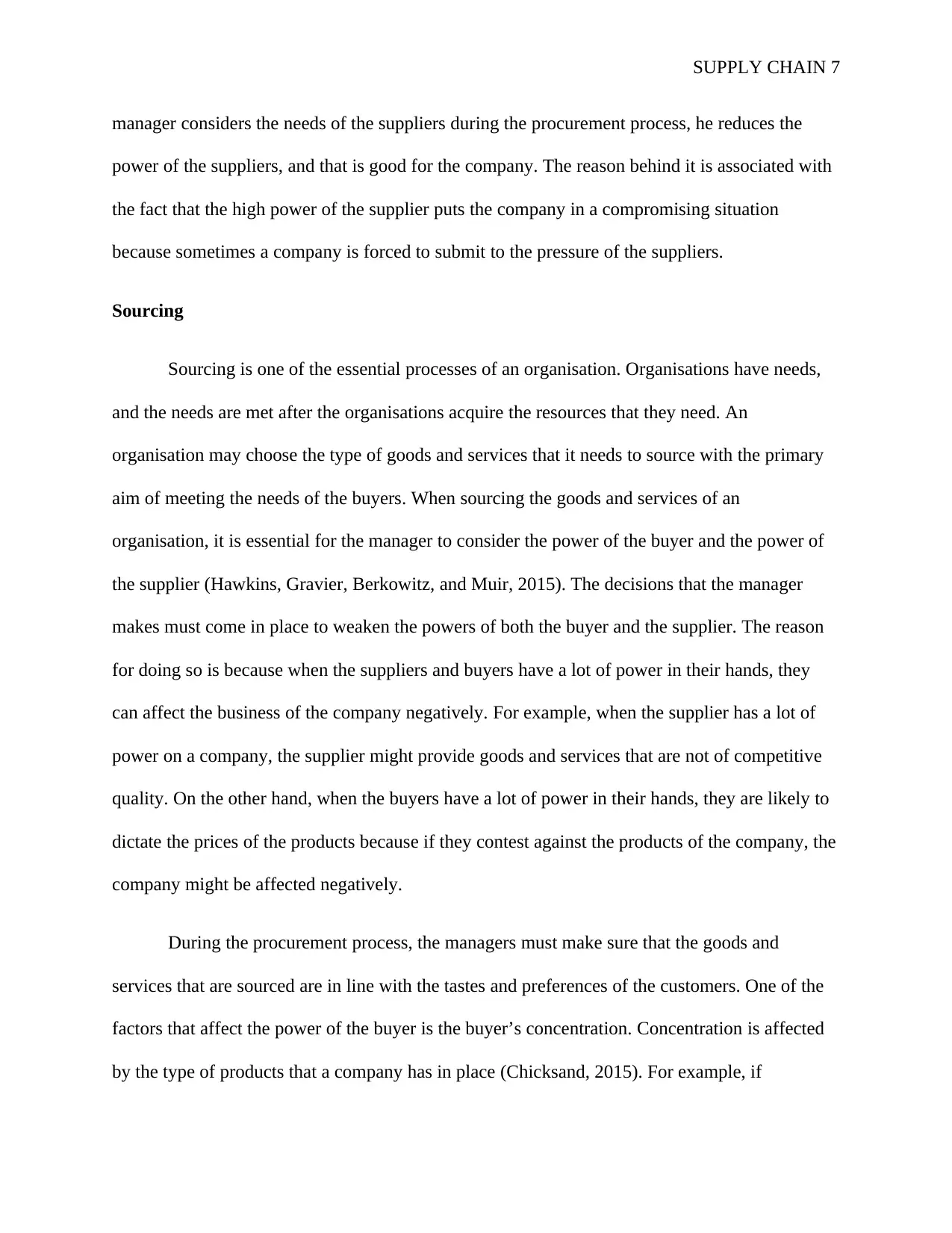
SUPPLY CHAIN 7
manager considers the needs of the suppliers during the procurement process, he reduces the
power of the suppliers, and that is good for the company. The reason behind it is associated with
the fact that the high power of the supplier puts the company in a compromising situation
because sometimes a company is forced to submit to the pressure of the suppliers.
Sourcing
Sourcing is one of the essential processes of an organisation. Organisations have needs,
and the needs are met after the organisations acquire the resources that they need. An
organisation may choose the type of goods and services that it needs to source with the primary
aim of meeting the needs of the buyers. When sourcing the goods and services of an
organisation, it is essential for the manager to consider the power of the buyer and the power of
the supplier (Hawkins, Gravier, Berkowitz, and Muir, 2015). The decisions that the manager
makes must come in place to weaken the powers of both the buyer and the supplier. The reason
for doing so is because when the suppliers and buyers have a lot of power in their hands, they
can affect the business of the company negatively. For example, when the supplier has a lot of
power on a company, the supplier might provide goods and services that are not of competitive
quality. On the other hand, when the buyers have a lot of power in their hands, they are likely to
dictate the prices of the products because if they contest against the products of the company, the
company might be affected negatively.
During the procurement process, the managers must make sure that the goods and
services that are sourced are in line with the tastes and preferences of the customers. One of the
factors that affect the power of the buyer is the buyer’s concentration. Concentration is affected
by the type of products that a company has in place (Chicksand, 2015). For example, if
manager considers the needs of the suppliers during the procurement process, he reduces the
power of the suppliers, and that is good for the company. The reason behind it is associated with
the fact that the high power of the supplier puts the company in a compromising situation
because sometimes a company is forced to submit to the pressure of the suppliers.
Sourcing
Sourcing is one of the essential processes of an organisation. Organisations have needs,
and the needs are met after the organisations acquire the resources that they need. An
organisation may choose the type of goods and services that it needs to source with the primary
aim of meeting the needs of the buyers. When sourcing the goods and services of an
organisation, it is essential for the manager to consider the power of the buyer and the power of
the supplier (Hawkins, Gravier, Berkowitz, and Muir, 2015). The decisions that the manager
makes must come in place to weaken the powers of both the buyer and the supplier. The reason
for doing so is because when the suppliers and buyers have a lot of power in their hands, they
can affect the business of the company negatively. For example, when the supplier has a lot of
power on a company, the supplier might provide goods and services that are not of competitive
quality. On the other hand, when the buyers have a lot of power in their hands, they are likely to
dictate the prices of the products because if they contest against the products of the company, the
company might be affected negatively.
During the procurement process, the managers must make sure that the goods and
services that are sourced are in line with the tastes and preferences of the customers. One of the
factors that affect the power of the buyer is the buyer’s concentration. Concentration is affected
by the type of products that a company has in place (Chicksand, 2015). For example, if
Paraphrase This Document
Need a fresh take? Get an instant paraphrase of this document with our AI Paraphraser
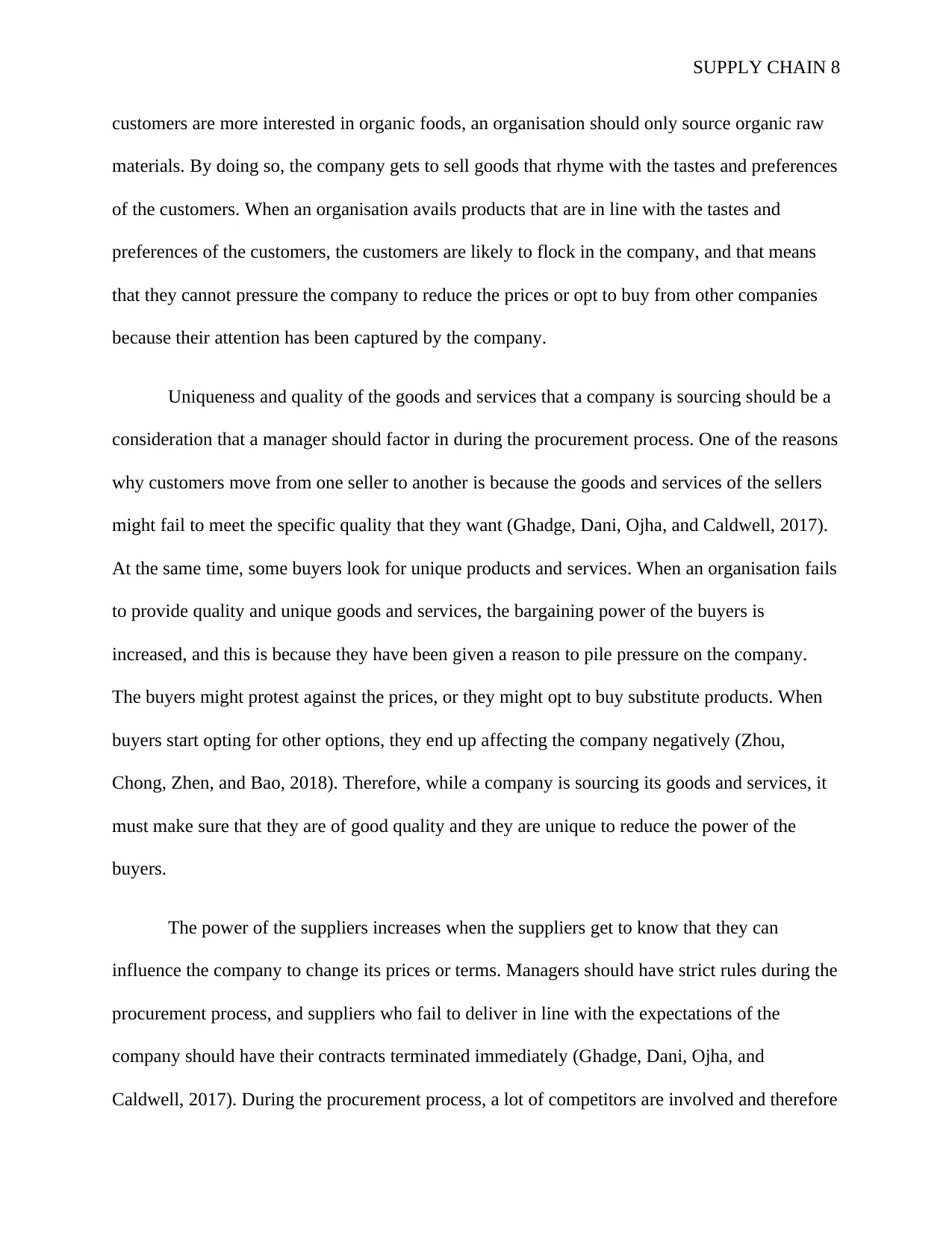
SUPPLY CHAIN 8
customers are more interested in organic foods, an organisation should only source organic raw
materials. By doing so, the company gets to sell goods that rhyme with the tastes and preferences
of the customers. When an organisation avails products that are in line with the tastes and
preferences of the customers, the customers are likely to flock in the company, and that means
that they cannot pressure the company to reduce the prices or opt to buy from other companies
because their attention has been captured by the company.
Uniqueness and quality of the goods and services that a company is sourcing should be a
consideration that a manager should factor in during the procurement process. One of the reasons
why customers move from one seller to another is because the goods and services of the sellers
might fail to meet the specific quality that they want (Ghadge, Dani, Ojha, and Caldwell, 2017).
At the same time, some buyers look for unique products and services. When an organisation fails
to provide quality and unique goods and services, the bargaining power of the buyers is
increased, and this is because they have been given a reason to pile pressure on the company.
The buyers might protest against the prices, or they might opt to buy substitute products. When
buyers start opting for other options, they end up affecting the company negatively (Zhou,
Chong, Zhen, and Bao, 2018). Therefore, while a company is sourcing its goods and services, it
must make sure that they are of good quality and they are unique to reduce the power of the
buyers.
The power of the suppliers increases when the suppliers get to know that they can
influence the company to change its prices or terms. Managers should have strict rules during the
procurement process, and suppliers who fail to deliver in line with the expectations of the
company should have their contracts terminated immediately (Ghadge, Dani, Ojha, and
Caldwell, 2017). During the procurement process, a lot of competitors are involved and therefore
customers are more interested in organic foods, an organisation should only source organic raw
materials. By doing so, the company gets to sell goods that rhyme with the tastes and preferences
of the customers. When an organisation avails products that are in line with the tastes and
preferences of the customers, the customers are likely to flock in the company, and that means
that they cannot pressure the company to reduce the prices or opt to buy from other companies
because their attention has been captured by the company.
Uniqueness and quality of the goods and services that a company is sourcing should be a
consideration that a manager should factor in during the procurement process. One of the reasons
why customers move from one seller to another is because the goods and services of the sellers
might fail to meet the specific quality that they want (Ghadge, Dani, Ojha, and Caldwell, 2017).
At the same time, some buyers look for unique products and services. When an organisation fails
to provide quality and unique goods and services, the bargaining power of the buyers is
increased, and this is because they have been given a reason to pile pressure on the company.
The buyers might protest against the prices, or they might opt to buy substitute products. When
buyers start opting for other options, they end up affecting the company negatively (Zhou,
Chong, Zhen, and Bao, 2018). Therefore, while a company is sourcing its goods and services, it
must make sure that they are of good quality and they are unique to reduce the power of the
buyers.
The power of the suppliers increases when the suppliers get to know that they can
influence the company to change its prices or terms. Managers should have strict rules during the
procurement process, and suppliers who fail to deliver in line with the expectations of the
company should have their contracts terminated immediately (Ghadge, Dani, Ojha, and
Caldwell, 2017). During the procurement process, a lot of competitors are involved and therefore
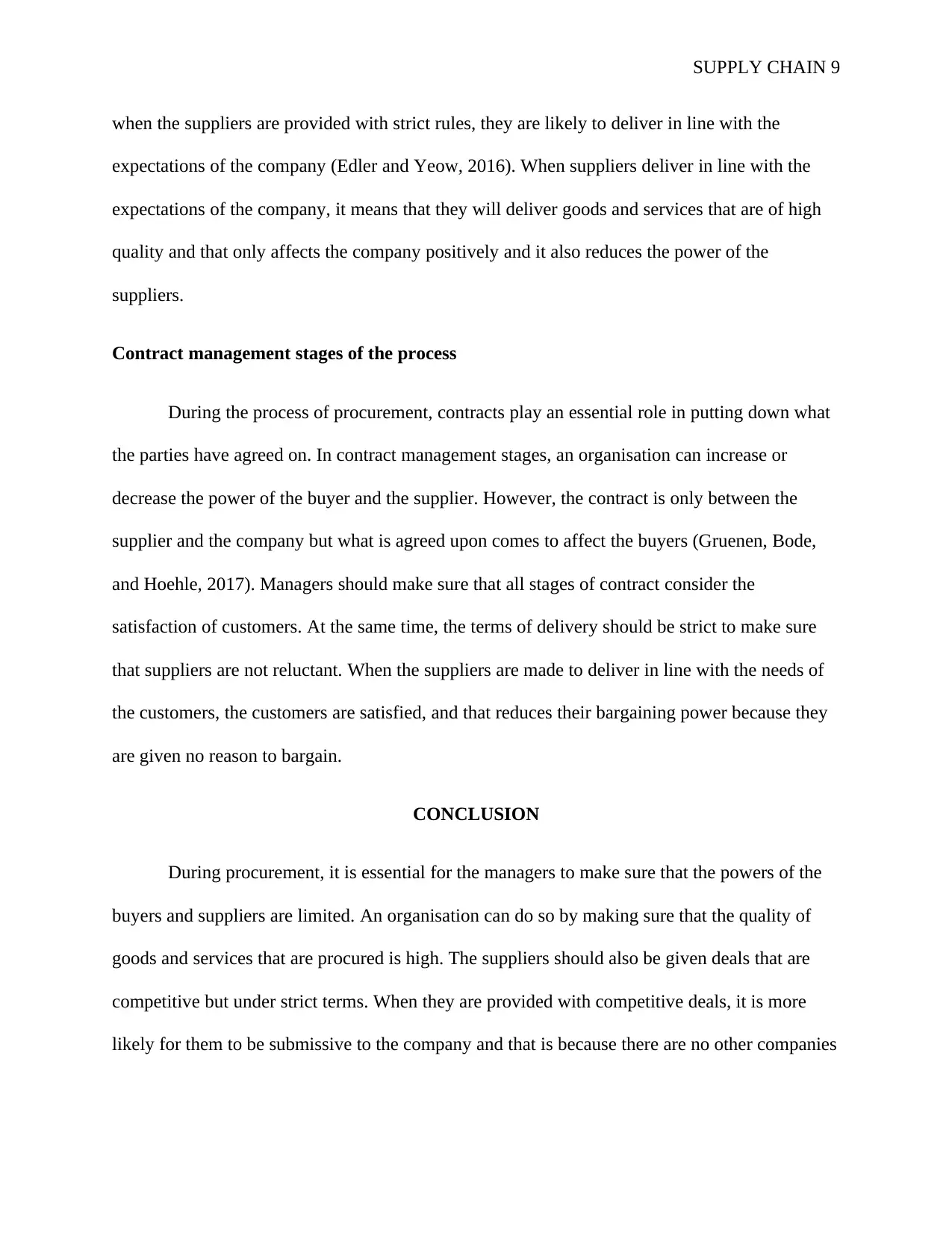
SUPPLY CHAIN 9
when the suppliers are provided with strict rules, they are likely to deliver in line with the
expectations of the company (Edler and Yeow, 2016). When suppliers deliver in line with the
expectations of the company, it means that they will deliver goods and services that are of high
quality and that only affects the company positively and it also reduces the power of the
suppliers.
Contract management stages of the process
During the process of procurement, contracts play an essential role in putting down what
the parties have agreed on. In contract management stages, an organisation can increase or
decrease the power of the buyer and the supplier. However, the contract is only between the
supplier and the company but what is agreed upon comes to affect the buyers (Gruenen, Bode,
and Hoehle, 2017). Managers should make sure that all stages of contract consider the
satisfaction of customers. At the same time, the terms of delivery should be strict to make sure
that suppliers are not reluctant. When the suppliers are made to deliver in line with the needs of
the customers, the customers are satisfied, and that reduces their bargaining power because they
are given no reason to bargain.
CONCLUSION
During procurement, it is essential for the managers to make sure that the powers of the
buyers and suppliers are limited. An organisation can do so by making sure that the quality of
goods and services that are procured is high. The suppliers should also be given deals that are
competitive but under strict terms. When they are provided with competitive deals, it is more
likely for them to be submissive to the company and that is because there are no other companies
when the suppliers are provided with strict rules, they are likely to deliver in line with the
expectations of the company (Edler and Yeow, 2016). When suppliers deliver in line with the
expectations of the company, it means that they will deliver goods and services that are of high
quality and that only affects the company positively and it also reduces the power of the
suppliers.
Contract management stages of the process
During the process of procurement, contracts play an essential role in putting down what
the parties have agreed on. In contract management stages, an organisation can increase or
decrease the power of the buyer and the supplier. However, the contract is only between the
supplier and the company but what is agreed upon comes to affect the buyers (Gruenen, Bode,
and Hoehle, 2017). Managers should make sure that all stages of contract consider the
satisfaction of customers. At the same time, the terms of delivery should be strict to make sure
that suppliers are not reluctant. When the suppliers are made to deliver in line with the needs of
the customers, the customers are satisfied, and that reduces their bargaining power because they
are given no reason to bargain.
CONCLUSION
During procurement, it is essential for the managers to make sure that the powers of the
buyers and suppliers are limited. An organisation can do so by making sure that the quality of
goods and services that are procured is high. The suppliers should also be given deals that are
competitive but under strict terms. When they are provided with competitive deals, it is more
likely for them to be submissive to the company and that is because there are no other companies
⊘ This is a preview!⊘
Do you want full access?
Subscribe today to unlock all pages.

Trusted by 1+ million students worldwide

SUPPLY CHAIN 10
to turn to. When suppliers are loyal and submissive to the company, they are not likely to pile
negative pressure on the company.
to turn to. When suppliers are loyal and submissive to the company, they are not likely to pile
negative pressure on the company.
Paraphrase This Document
Need a fresh take? Get an instant paraphrase of this document with our AI Paraphraser
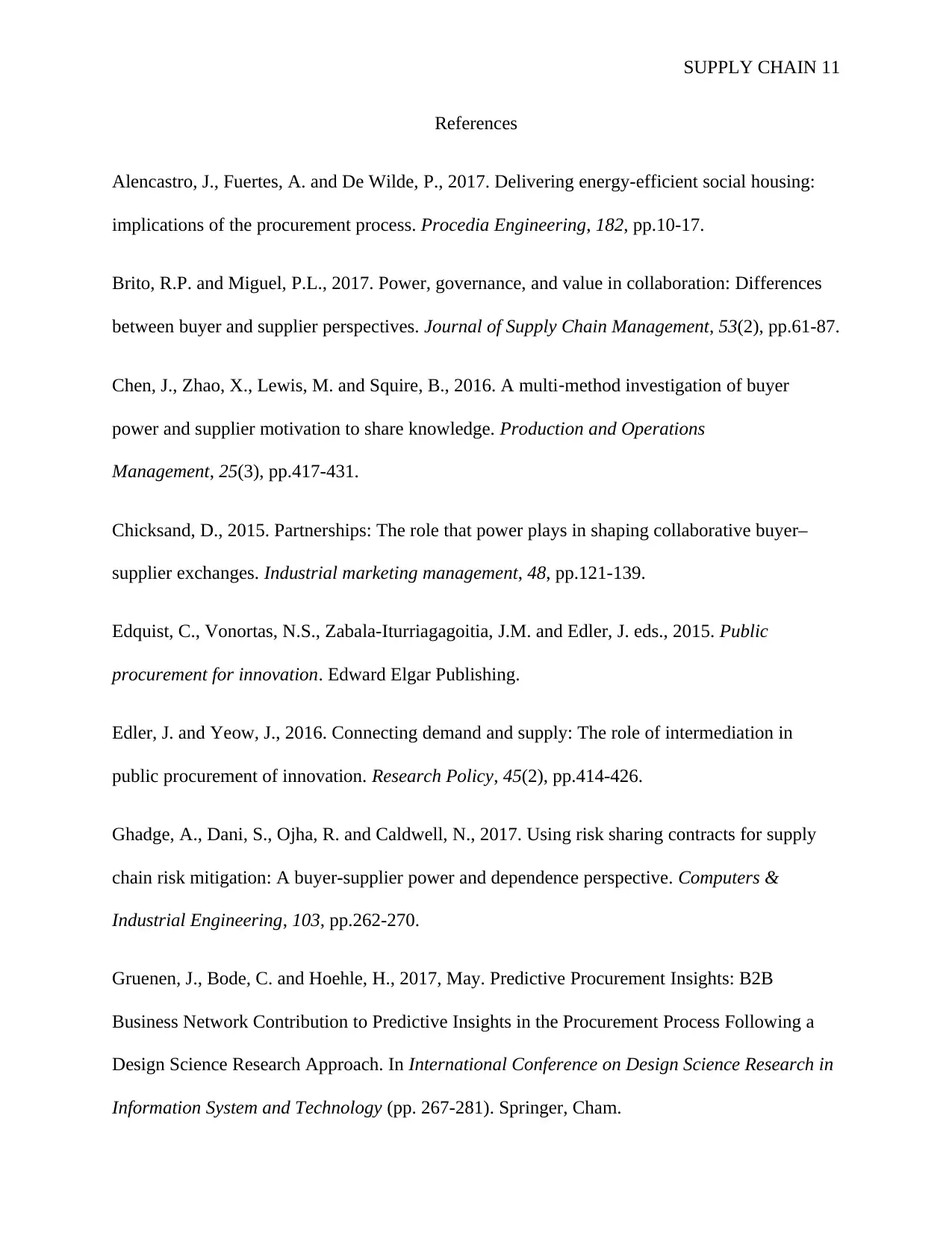
SUPPLY CHAIN 11
References
Alencastro, J., Fuertes, A. and De Wilde, P., 2017. Delivering energy-efficient social housing:
implications of the procurement process. Procedia Engineering, 182, pp.10-17.
Brito, R.P. and Miguel, P.L., 2017. Power, governance, and value in collaboration: Differences
between buyer and supplier perspectives. Journal of Supply Chain Management, 53(2), pp.61-87.
Chen, J., Zhao, X., Lewis, M. and Squire, B., 2016. A multi‐method investigation of buyer
power and supplier motivation to share knowledge. Production and Operations
Management, 25(3), pp.417-431.
Chicksand, D., 2015. Partnerships: The role that power plays in shaping collaborative buyer–
supplier exchanges. Industrial marketing management, 48, pp.121-139.
Edquist, C., Vonortas, N.S., Zabala-Iturriagagoitia, J.M. and Edler, J. eds., 2015. Public
procurement for innovation. Edward Elgar Publishing.
Edler, J. and Yeow, J., 2016. Connecting demand and supply: The role of intermediation in
public procurement of innovation. Research Policy, 45(2), pp.414-426.
Ghadge, A., Dani, S., Ojha, R. and Caldwell, N., 2017. Using risk sharing contracts for supply
chain risk mitigation: A buyer-supplier power and dependence perspective. Computers &
Industrial Engineering, 103, pp.262-270.
Gruenen, J., Bode, C. and Hoehle, H., 2017, May. Predictive Procurement Insights: B2B
Business Network Contribution to Predictive Insights in the Procurement Process Following a
Design Science Research Approach. In International Conference on Design Science Research in
Information System and Technology (pp. 267-281). Springer, Cham.
References
Alencastro, J., Fuertes, A. and De Wilde, P., 2017. Delivering energy-efficient social housing:
implications of the procurement process. Procedia Engineering, 182, pp.10-17.
Brito, R.P. and Miguel, P.L., 2017. Power, governance, and value in collaboration: Differences
between buyer and supplier perspectives. Journal of Supply Chain Management, 53(2), pp.61-87.
Chen, J., Zhao, X., Lewis, M. and Squire, B., 2016. A multi‐method investigation of buyer
power and supplier motivation to share knowledge. Production and Operations
Management, 25(3), pp.417-431.
Chicksand, D., 2015. Partnerships: The role that power plays in shaping collaborative buyer–
supplier exchanges. Industrial marketing management, 48, pp.121-139.
Edquist, C., Vonortas, N.S., Zabala-Iturriagagoitia, J.M. and Edler, J. eds., 2015. Public
procurement for innovation. Edward Elgar Publishing.
Edler, J. and Yeow, J., 2016. Connecting demand and supply: The role of intermediation in
public procurement of innovation. Research Policy, 45(2), pp.414-426.
Ghadge, A., Dani, S., Ojha, R. and Caldwell, N., 2017. Using risk sharing contracts for supply
chain risk mitigation: A buyer-supplier power and dependence perspective. Computers &
Industrial Engineering, 103, pp.262-270.
Gruenen, J., Bode, C. and Hoehle, H., 2017, May. Predictive Procurement Insights: B2B
Business Network Contribution to Predictive Insights in the Procurement Process Following a
Design Science Research Approach. In International Conference on Design Science Research in
Information System and Technology (pp. 267-281). Springer, Cham.
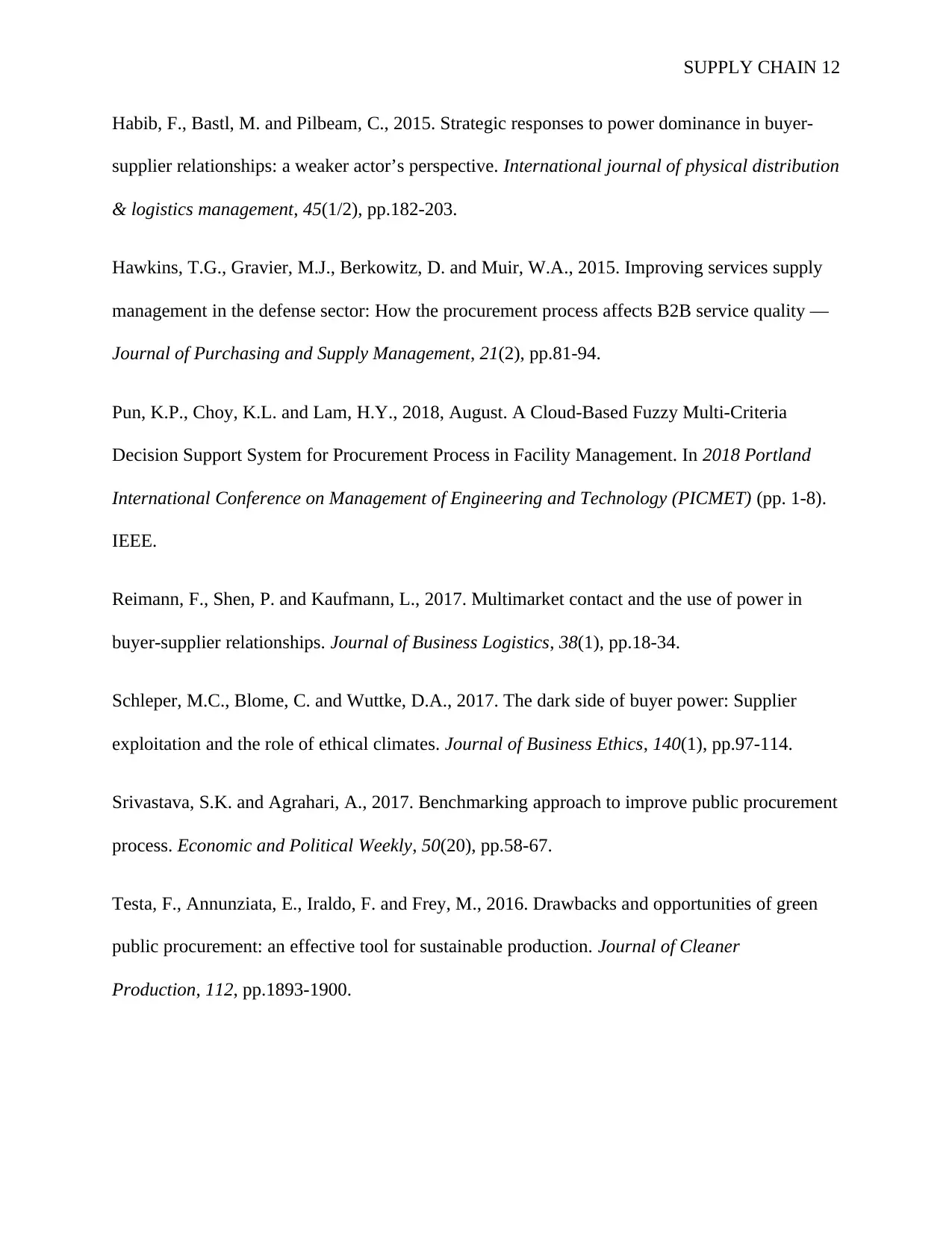
SUPPLY CHAIN 12
Habib, F., Bastl, M. and Pilbeam, C., 2015. Strategic responses to power dominance in buyer-
supplier relationships: a weaker actor’s perspective. International journal of physical distribution
& logistics management, 45(1/2), pp.182-203.
Hawkins, T.G., Gravier, M.J., Berkowitz, D. and Muir, W.A., 2015. Improving services supply
management in the defense sector: How the procurement process affects B2B service quality —
Journal of Purchasing and Supply Management, 21(2), pp.81-94.
Pun, K.P., Choy, K.L. and Lam, H.Y., 2018, August. A Cloud-Based Fuzzy Multi-Criteria
Decision Support System for Procurement Process in Facility Management. In 2018 Portland
International Conference on Management of Engineering and Technology (PICMET) (pp. 1-8).
IEEE.
Reimann, F., Shen, P. and Kaufmann, L., 2017. Multimarket contact and the use of power in
buyer-supplier relationships. Journal of Business Logistics, 38(1), pp.18-34.
Schleper, M.C., Blome, C. and Wuttke, D.A., 2017. The dark side of buyer power: Supplier
exploitation and the role of ethical climates. Journal of Business Ethics, 140(1), pp.97-114.
Srivastava, S.K. and Agrahari, A., 2017. Benchmarking approach to improve public procurement
process. Economic and Political Weekly, 50(20), pp.58-67.
Testa, F., Annunziata, E., Iraldo, F. and Frey, M., 2016. Drawbacks and opportunities of green
public procurement: an effective tool for sustainable production. Journal of Cleaner
Production, 112, pp.1893-1900.
Habib, F., Bastl, M. and Pilbeam, C., 2015. Strategic responses to power dominance in buyer-
supplier relationships: a weaker actor’s perspective. International journal of physical distribution
& logistics management, 45(1/2), pp.182-203.
Hawkins, T.G., Gravier, M.J., Berkowitz, D. and Muir, W.A., 2015. Improving services supply
management in the defense sector: How the procurement process affects B2B service quality —
Journal of Purchasing and Supply Management, 21(2), pp.81-94.
Pun, K.P., Choy, K.L. and Lam, H.Y., 2018, August. A Cloud-Based Fuzzy Multi-Criteria
Decision Support System for Procurement Process in Facility Management. In 2018 Portland
International Conference on Management of Engineering and Technology (PICMET) (pp. 1-8).
IEEE.
Reimann, F., Shen, P. and Kaufmann, L., 2017. Multimarket contact and the use of power in
buyer-supplier relationships. Journal of Business Logistics, 38(1), pp.18-34.
Schleper, M.C., Blome, C. and Wuttke, D.A., 2017. The dark side of buyer power: Supplier
exploitation and the role of ethical climates. Journal of Business Ethics, 140(1), pp.97-114.
Srivastava, S.K. and Agrahari, A., 2017. Benchmarking approach to improve public procurement
process. Economic and Political Weekly, 50(20), pp.58-67.
Testa, F., Annunziata, E., Iraldo, F. and Frey, M., 2016. Drawbacks and opportunities of green
public procurement: an effective tool for sustainable production. Journal of Cleaner
Production, 112, pp.1893-1900.
⊘ This is a preview!⊘
Do you want full access?
Subscribe today to unlock all pages.

Trusted by 1+ million students worldwide
1 out of 13
Related Documents
Your All-in-One AI-Powered Toolkit for Academic Success.
+13062052269
info@desklib.com
Available 24*7 on WhatsApp / Email
![[object Object]](/_next/static/media/star-bottom.7253800d.svg)
Unlock your academic potential
Copyright © 2020–2025 A2Z Services. All Rights Reserved. Developed and managed by ZUCOL.





